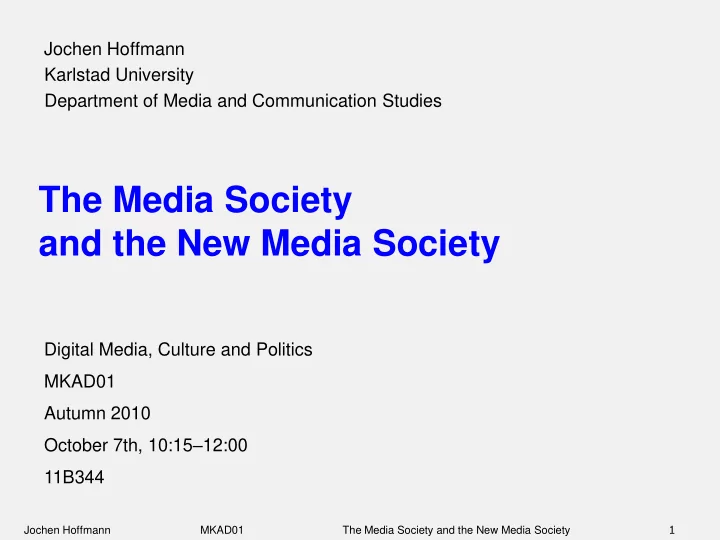

Jochen Hoffmann Karlstad University Department of Media and Communication Studies The Media Society and the New Media Society Digital Media, Culture and Politics MKAD01 Autumn 2010 October 7th, 10:15 – 12:00 11B344 1 Jochen Hoffmann MKAD01 The Media Society and the New Media Society
Trends in Society (based on Blumler/Kavanagh 1999) Modernization Individualization Secularization Economization Aestheticization Rationalization Mediatization 2 Jochen Hoffmann MKAD01 The Media Society and the New Media Society
Dominance of Media Logic? Mass Media Politics Economy Art Science Rules of the Public Sphere Personalization? Currency? Negativism? Conflict? 3 Jochen Hoffmann MKAD01 The Media Society and the New Media Society
Media Society (see Jarren/Donges 2002: 30-31) Increased range of media products Specialization of media formats Increased speed of media performances Increased attention to media Increased acceptance of public realities Medial penetration of the whole society? 4 Jochen Hoffmann MKAD01 The Media Society and the New Media Society
Mediatization of Politics? Economics Instrumentalization (Induction) Economization Decoupling Politics Media Mediatization (Adaptation) 5 Jochen Hoffmann MKAD01 The Media Society and the New Media Society
Publicity everywhere? We observed… …the decoupling of media from politics. Functional differentiated society ! … the economization of media. Economical society ! … the adaption of politics to media logic. Media Society ! … the instrumentalization of media by politics. Political Society ! 6 Jochen Hoffmann MKAD01 The Media Society and the New Media Society
Digital Media lat. digitus = finger Continuous ANALOG Signal Discrete DIGITAL Signal expressed by 0/1 code 7 Jochen Hoffmann MKAD01 The Media Society and the New Media Society
What is Special about Digital Media? Storing of huge amounts of information Easy access to information Integration of multiple communication modes (text, graphic, sound, video) Associative structure complements sequential structure of information (hypertext). Simultaneously information storing and communicating Supports both Push- and Pull-Strategies in communication management High connectivity due to universal ”language” (TCP/IP) Overcoming of time and space constraints (same or different time/place) Applicable to both interpersonal and mass communication (1:1, 1:n, n:1, n:n) Allows flexible switching between sender and recipient roles And finally: If new media ought to be successful, they must not be new. 8 Jochen Hoffmann MKAD01 The Media Society and the New Media Society
A Reciprocal Model effect launch Digital Producer Consumer Media use Selection of technology? Feedback Type of use? loop Intended use according to declared purpose Intended use not according to declared purpose Unintended use Cumulative usage patterns 9 Jochen Hoffmann MKAD01 The Media Society and the New Media Society
The Transformation Hypothesis „By using the Internet as a fundamental medium of communication and information-processing, business adopts the network as its organizational form.“ (Castells 2001: 66) New Technology Traditional Network Organization Enterprise 10 Jochen Hoffmann MKAD01 The Media Society and the New Media Society
Application to Politics Traditional political communication as a linear process Interests Information Public Public State Politics Political communication in the network society „Open generative informational loops“ structured by „recursive governance“ Governance “refers to governing modes in which government is only one among several actors involved in governance. In this understanding, distinctions between, and within, public and private sectors become blurred such that governing mecha- nisms are no longer underpinned solely by the authority of the state but rely upon the interaction of multiple actors and their influence on each other. In these terms, governance is a multi- stakeholderprocess with actors drawn from market and civil society institutions as well as from government.” (Crozier 2007:3) 11 Jochen Hoffmann MKAD01 The Media Society and the New Media Society
Characteristics of Networks Autonomous elements Loosely connected Not enduring Flexible scalability Functional relations Flat hierarchies Self-organizing Coordinating management Representing ”modernism” Diminishing organizational boundaries 12 Jochen Hoffmann MKAD01 The Media Society and the New Media Society
The Function of Structure: Boundary Enables Identity 13 Jochen Hoffmann MKAD01 The Media Society and the New Media Society
Project Orientation Replaces Organizational Boundaries PROJECT Organization Organization Organization „Thus, the network enterprise is neither a network of enterprises nor an intra- firm, networked organization. Rather, it is a lean agency of economic activity, built around specific business projects ( … ): the network is the enterprise “ (Castells 2001: 67) 14 Jochen Hoffmann MKAD01 The Media Society and the New Media Society
Challenges for Network Enterprises Economies of Scale Networks allow for a customization of products and services. Their unstable structure complies less with the need for standardization which is necessary to reduce production costs. Branding The autonomy of its elements impedes the chances of network enterprises to develop an inimitable identity and a clear brand. Accountability If self-organizing network structures fail to operate properly, it will become difficult to identify the source of the problem and the social position which can be held to account. 15 Jochen Hoffmann MKAD01 The Media Society and the New Media Society
Potential Effects of Communication Technologies on Hierarchies Bottom Up Top Down Access Open access Restricted access to relevant information Information storage Transparency Information overload Skills Inhouse trainings on new Digital divide technologies Specialisation Reduction of formal Emergence of informal hierarchies hierarchies Permeability Overleaping of hierarchy Communication triage levels Internal Monitoring Traceable collaborative Surveillance work External Monitoring Countercheck Violating privacy management positions „Polyglot“ external Outgoing information Public relations communication monopoly Scope for development Use of creativity enabling High regulation by use of software digital templates 16 Jochen Hoffmann MKAD01 The Media Society and the New Media Society
Digital Media Technologies as a Social Tool Digital media technologies have no inbuilt political bias: neither towards the strengthening of hierarchies nor towards more democracy at the workplace. It is up to the people who use technologies as a tool. From a normative point of view, organizations are successful, if digital media help them to find an appropriate balance between… Bottom-Up-Participation Top-Down-Leadership Challenging power structures Legitimizing power structures Individual freedom Organizational actionability Encouraging creativity Reliable standardization Enabling innovation Reliance on experience 17 Jochen Hoffmann MKAD01 The Media Society and the New Media Society
Recommend
More recommend